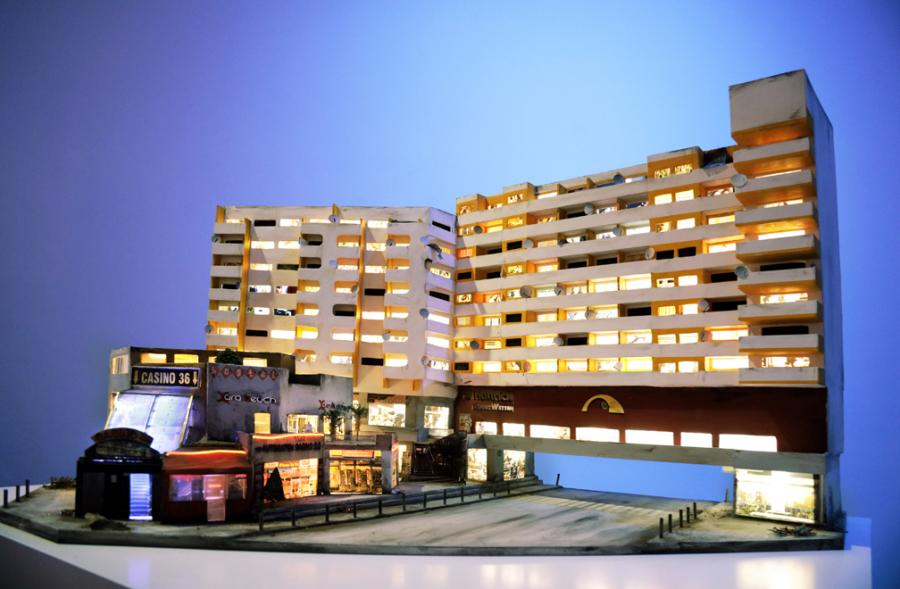Tracey Snelling at Künstlerhaus Bethanien
Tracey Snelling at Künstlerhaus Bethanien

Tracey Snelling’s solo exhibition, First We Take Manhattan, at Künstlerhaus Bethanien presents intricately detailed sets filled with the minutia of everyday life – viewed through a lens that zooms both out and in – from cities to buildings to individual rooms.
The artist's photographic background and interest in collage manifests in the material and visual hodge-podge of open stages in both miniature and life size that seem built to be photographed or filmed – meticulously arranged as though awaiting the attentive eye of a camera. Indeed, in close-up photographs of the miniatures, the question of scale filters through, as the tiny scenes become difficult to distinguish from an inhabitable environment.
Within the dimmed exhibition space, these stage-sets bleed out from their constructed environments, as overhead lights in pink and blue reproduce the overall atmosphere of a nightclub or lounge-like setting. From the various installations, meanwhile, voices, ambient sound and music spill out into the space and become entangled. Compiled from sheets of plywood, plastic food packaging and objects found in second-hand shops, a makeshift, eclectic aesthetic predominates in the garish decoration and cacophony of color, engineering a sensory bombardment and a reference to the profusion of detritus in a throwaway culture – the discarded pieces from which many construct their lives.

'Play Motel', 2018, 20 x 80 x 26 cm
Snelling hones in on the idiosyncrasies of a place, at the same time making visible broader issues of overpopulation, global poverty and the overarching sense of chaos and precariousness that seeps through life in the big city. An artist in residence at Kunstlerhaus Bethanien, Snelling’s current work is largely focused on her immediate Kreuzberg surroundings, materialized in reconstructions of the corner Doner shop, as well as the haphazard architectural constellation around Kotti – including markers such as Casino 36 and Xara beach. The miniatures of such familiar locales appear near exact, but they are more approximations, seeking to capture a particular atmosphere and its general configuration – recreating the experience of a place.
These small-scale replicas beckon close interaction, as advertisements, images, video, pop cultural references and décor produce myriad images to be taken in and hidden gems to be discovered. Similar in scale, a towering installation in the form of a high-rise, densely packed apartment building occupies another corner of the exhibition space. Here, piled high, grids of tiny windows display a variety of images, both still and moving, sourced both from random internet searches and personal memories. The stacked-up compilation of windowed boxes that comprise ‘Tenement Rising’ not only gives the impression that it can eternally be added onto, stacked higher and higher, expanded in all directions, but it is also as though an entire city’s buildings have been condensed and collapsed into a single unit, ill-fittingly stitched together.

Exhibition View, 'Tenement Rising' and 'Living Room', mixed media installations with video
We are permitted to enter into this microcosm; moving behind its façade we get a glimpse of its inner workings – the tangled mass of wires that power the lights and small video screens that populate its windows, connecting everything in a seemingly delicate, unstable way. Projected on the wall just beyond this sculptural installation, is video footage of a similar building assemblage. It’s a view we can imagine the residences of the tenement look out onto, the two constructions producing their own city skyline. However, it’s also a mirror effect – a doubling of images – producing repetition upon repetition.
A sense of endless mirroring and repetition pervades both within each installation and in the interactions between them. Installed on the wall opposite ‘Tenement Rising’ a series of dioramas in a slightly larger scale offer a closer look into different themed rooms: a room decorated for Christmas, the room of a serial killer, a Spätkauf and an erotic motel. This series of isolated though connected rooms – like the rows of apartment windows, each containing their own, disconnected scene – faces an installation of two other side-by-side interiors, this time blown up to life size. In these rooms, live performances have taken place over the course of the exhibition, giving a voyeuristic peek into such mundane and solitary activities as watching television, masturbating or building a house of cards, and, alternatively, weirder moments in which performers wear masks, wrestle in tighty whities and play with a stuffed unicorn. Recordings of these performances subsequently appear on the television screens placed inside the rooms – once again reminiscent of the videos played on tiny screens in the windows of the adjacent miniatures.

Performance by Patrick Bartsch in 'Living Room'
In the juxtaposition of screens that we can look at and spaces we can step into, the distinction between looking into and looking out from becomes hazy – reality becomes indecipherable from fantasy, a thing inseparable from its representation. Like movie sets, Snelling’s scenes are elaborately and painstakingly designed, rooted in the recognizable, yet somehow disorienting, fantastical but also mundane. She focuses in on and highlights the dark corners, the rabbit holes, as well as the ubiquitous and ordinary, ultimately displaying our realities as multitudinous, and always just as strange, messy and precarious.
***
Tracey Snelling First We Take Manhattan Künstlerhaus Bethanien Closes February 11, 2018 Closing Performance Sunday, February 11, 17.00-19.00